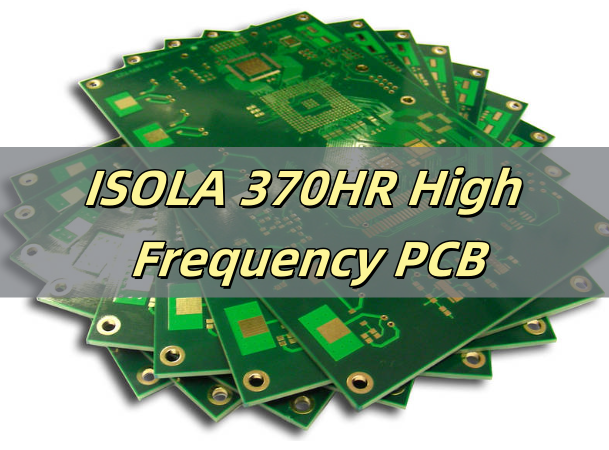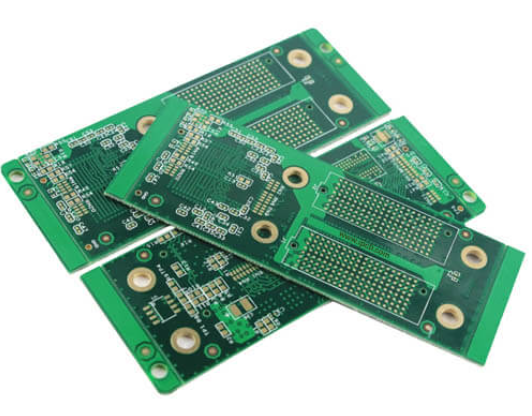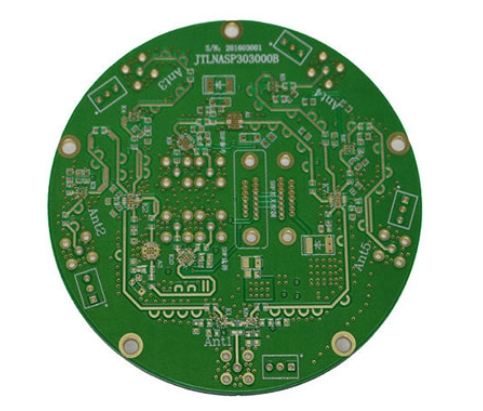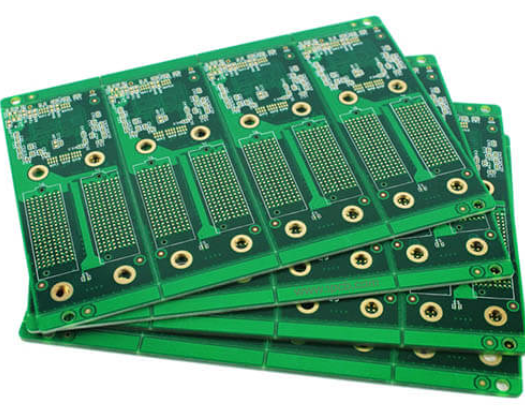Isola 370HR is a well-established choice for engineers who need a durable, high-frequency compatible PCB base material. Its high Tg, low loss, and excellent reliability make it suitable for everything from aerospace to telecommunications.
If you’re working on a complex design or RF application, switching to Isola 370HR PCB materials might be the upgrade you need. And with a reliable partner like EBest Circuit (Best Technology), you’re assured of quality from the first prototype to volume production.

What Is Isola 370HR Material?
Isola 370HR is a high-performance, high-Tg epoxy laminate and prepreg system developed by Isola Group. Designed specifically for multilayer printed circuit boards, it offers a great balance between electrical stability and thermal durability. Itâs classified as a high-Tg FR4 material but provides better signal handling and thermal behavior compared to standard FR4.
Isola engineered this material for demanding sectors like telecommunications, data networking, and military electronics. Its low dielectric loss and stable performance across a wide frequency range make it suitable for modern high-speed circuits.
Advantages of Using Isola 370HR in PCB Manufacturing
Choosing Isola 370HR for your PCB manufacturing brings several key benefits that directly impact the performance and reliability of your finished products:
- Superior Thermal Stability: With a high glass transition temperature (~180°C), Isola 370HR withstands the high temperatures of lead-free soldering and multiple reflow cycles without warping or delamination.
- Low Dielectric Loss: This material minimizes signal loss at high frequencies, making it perfect for RF circuits and high-speed digital designs.
- Excellent Signal Integrity: Stable dielectric constant (Dk) across frequency ranges means consistent signal propagation and reduced timing errors.
- Enhanced Moisture and CAF Resistance: Improved resistance to moisture-induced failures helps maintain long-term reliability, especially in humid or harsh environments.
- Dimensional Stability: Reduced Z-axis expansion ensures layers stay aligned during manufacturing and operation, critical for multilayer PCBs.
- IPC Compliance: Isola 370HR meets rigorous industry standards, ensuring compatibility with demanding aerospace, automotive, and medical applications.
- RoHS and Environmental Compliance: Fully compliant with environmental regulations, supporting green manufacturing practices.

ISOLA 370HR Datasheet
| Property | Typical Value | Test Method / Notes |
| Glass Transition Temperature (Tg) | 180°C (DSC) | Differential Scanning Calorimetry |
| Decomposition Temperature (Td) | >340°C | TGA (Thermogravimetric Analysis) |
| Dielectric Constant (Dk) | 4.04 @ 1 GHz | IPC-TM-650 2.5.5.5 |
| Dissipation Factor (Df) | 0.0127 @ 1 GHz | IPC-TM-650 2.5.5.5 |
| Coefficient of Thermal Expansion (CTE) | 15 ppm/°C (X-Y), 65 ppm/°C (Z) | IPC-TM-650 2.4.24 |
| Thermal Conductivity | 0.4 W/m·K | ASTM E1461 |
| Tensile Strength | 24,000 psi | IPC-TM-650 2.4.18 |
| Flexural Strength | 32,000 psi | IPC-TM-650 2.4.4 |
| Water Absorption | <0.10% | IPC-TM-650 2.6.2.1 |
| Flammability Rating | UL 94 V-0 | UL 94 |
| Copper Peel Strength | >1.0 lbs/inch | IPC-TM-650 2.4.8 |
| Surface Resistivity | >1×10^6 ohms | ASTM D257 |
| Volume Resistivity | >1×10^9 ohm-cm | ASTM D257 |
| Dielectric Breakdown Voltage | >50 kV/mm | IPC-TM-650 2.5.6 |
What Is the Difference Between FR4 and 370HR?
While both standard FR4 and Isola 370HR are epoxy-based materials widely used in PCB manufacturing, they differ significantly in performanceâespecially when it comes to high-speed and high-frequency applications.
Standard FR4 is the go-to material for many general-purpose PCBs. It offers decent mechanical strength, good manufacturability, and cost-effectiveness for everyday electronics. However, its glass transition temperature (Tg) typically ranges from 130°C to 140°C, and it has relatively higher dielectric loss (Df). These limitations can cause signal degradation and reliability issues in circuits operating at higher frequencies or elevated temperatures.
In contrast, Isola 370HR is a high-Tg FR4 variant designed to meet the demands of more challenging environments. Its Tg is around 180°C, which provides superior thermal stability during lead-free soldering and extended use in high-temperature settings. More importantly, it exhibits a lower dielectric constant (Dk) and dissipation factor (Df), which translates to lower signal loss and better signal integrity at microwave and radio frequencies.

Why Isola 370HR PCBs Are Suitable for High Frequency Applications?
As electronic devices evolve to support faster data rates, the performance of PCB materials under high-frequency conditions has become a serious concern. This is where Isola 370HR PCB materials shine.
Its consistent dielectric constant (Dk) and low dissipation factor (Df) ensure that high-frequency signals do not lose strength or become distorted. Thatâs a major reason why 370HR is used in:
- Gigabit Ethernet systems
- High-speed backplanes
- Automotive radar systems
- Satellite communications
- Advanced test equipment
Its ability to handle GHz-level signals without distortion helps maintain data accuracy and reduces EMI-related issues.
When to Choose Isola 370HR Material for Your PCB?
You might consider Isola 370HR when your design falls into any of the following categories:
High-speed or RF designs: If your circuit runs at over 1 GHz, this material can preserve signal quality.
- Multilayer PCBs: When stacking 8 or more layers, 370HR offers great registration control and stability.
- Thermal stress tolerance: It performs reliably through multiple reflow cycles and temperature extremes.
- CAF-resistant needs: Ideal for products exposed to moisture or long-term outdoor use.
- Strict industry compliance: It meets IPC-4101/126 and 129, as well as UL and RoHS requirements.
Choosing this material isnât just about performanceâitâs about peace of mind over the productâs lifecycle.

How to Identify Genuine Isola 370HR PCB Material?
To avoid counterfeit materials or unverified substitutions, itâs important to:
- Request the original datasheet with the Isola logo and batch number.
- Check board markings for Isola brand identification or laminate codes.
- Work with certified suppliers who purchase directly from Isola or its authorized distributors.
- Ask for certification documents, especially if your application is regulated by aerospace or medical standards.
- Genuine Isola 370HR PCB materials ensure consistency in production and performance.
Typical Applications of Isola 370HR in PCB Design
Here are common industries and devices where Isola 370HR is frequently used:
- Telecommunications: High-speed switches, routers, and fiber optic systems.
- Aerospace and Defense: Radar, avionics, satellite boards.
- Medical Equipment: Imaging devices, patient monitoring systems.
- Automotive: Advanced driver-assistance systems (ADAS), LiDAR modules.
- Industrial Automation: Motor controls, power management systems.
Designers across these sectors rely on its thermal reliability and signal control to reduce field failures.
What Is the Equivalent of Isola 370HR?
While Isola 370HR is a preferred material, there are other options that offer similar characteristics. Hereâs how some alternatives compare:
| Material Name | Tg (°C) | Df @ 1GHz | Notable Feature |
| Nelco N4000-13EP | ~180 | ~0.013 | Known for stability |
| Panasonic MEGTRON 6 | ~185 | ~0.0025 | Ultra-low loss, but expensive |
| Ventec VT-47 | ~180 | ~0.014 | Cost-effective option |
If you need better electrical performance than 370HR, MEGTRON 6 is a great choice. For general high-frequency use with cost control, 370HR remains the most balanced option.
Why Choose EBest Circuit (Best Technology) for Isola 370HR PCB Manufacturing?
With over 18 years of experience in printed circuit boards and as one of the leading PCB manufacturers, we support over 1,000 customers in different industrial areas worldwide. You can count on a PCB board manufacturer like us to meet your one-stop electronics manufacturing demands.
We are your one-stop PCB manufacturer in China who can meet all your diversified PCB requirements. We have an experienced engineering, production, and quality team that fully understands the unique needs of your industryâespecially in medical, automotive, and aerospace applications. As a printed circuit board manufacturer, we always follow the most widely accepted standards in the industry: IPC-A-600 for fabrication and IPC-A-610 for PCB assembly. All our products meet IPC Class 2 by default, and we can also meet Class 3 or 3A when your application requires it.
If you have any questions about our products, services, pricing, lead times, quality control, certifications, or technical support, please feel free to contact us anytime. Our goal is to be one of the best PCB manufacturers in China, offering exceptional quality, fair pricing, and professional service.
FAQs
1. Is Isola 370HR good for RF applications?
Yes, it offers low dielectric loss and stable Dk, perfect for high-frequency circuits.
2. How is Isola 370HR different from standard FR4?
It has higher Tg, better thermal stability, and lower signal loss.
3. What industries use Isola 370HR PCB materials?
Telecom, automotive, aerospace, medical, and industrial electronics.
4. Can Isola 370HR support lead-free assembly?
Yes, itâs fully compatible with RoHS and lead-free soldering processes.
5. Where can I get a quote for Isola 370HR PCB fabrication?
Contact EBest Circuit (Best Technology) for fast, custom quotes and expert support.


